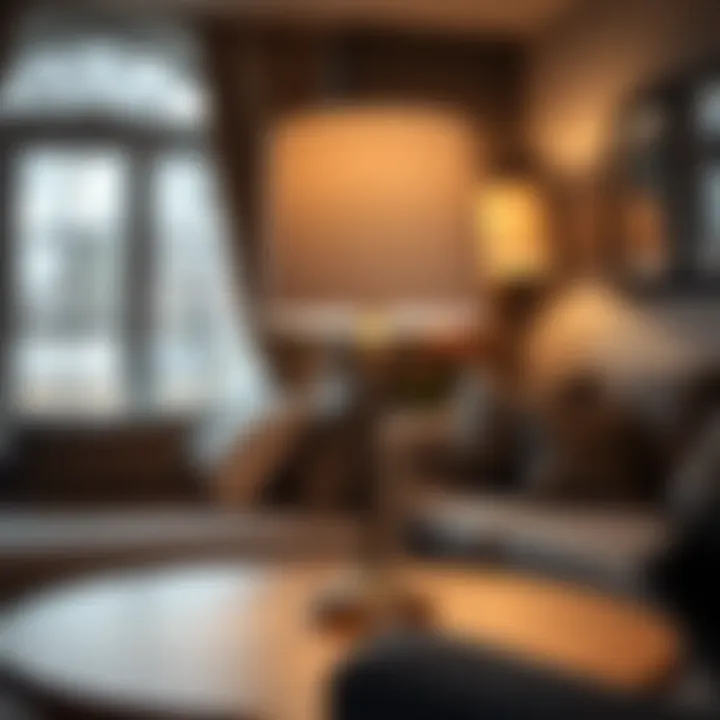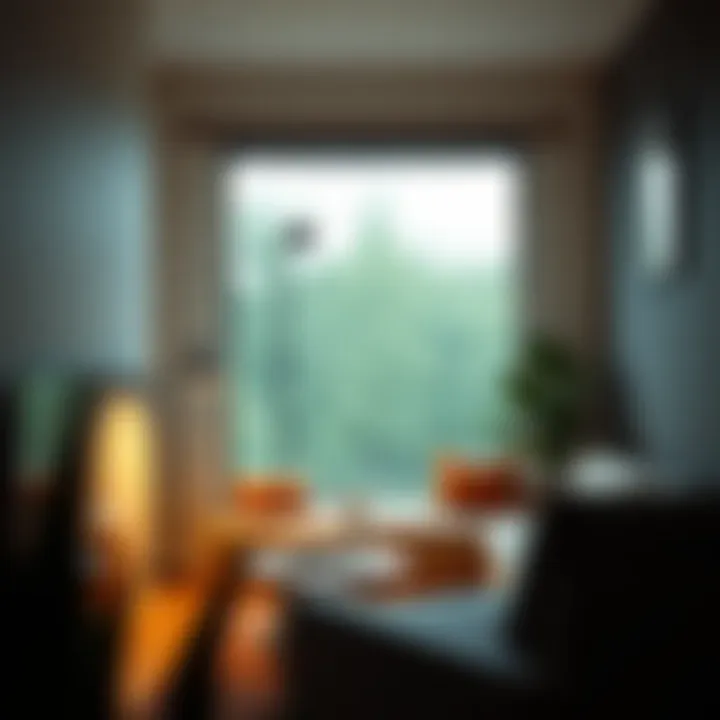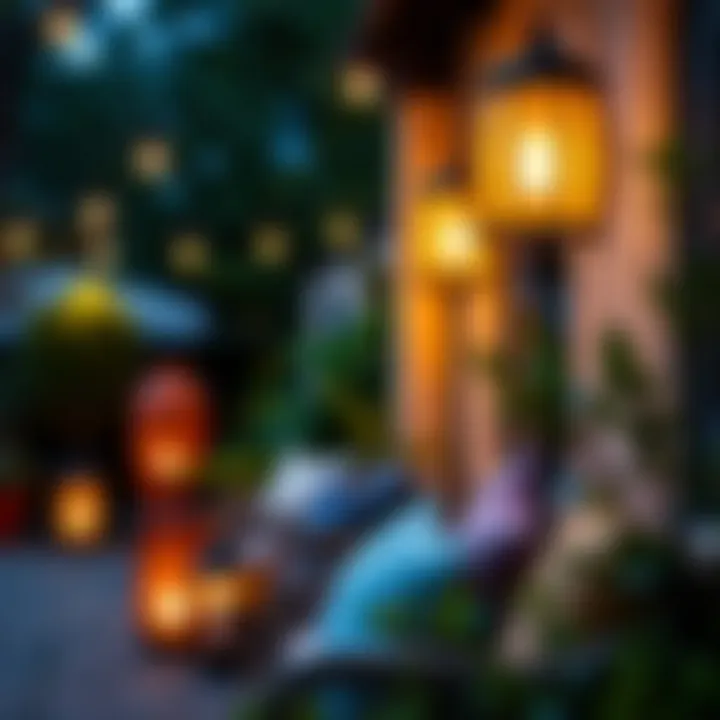Illuminating Spaces: Mastering Lamp Lighting Techniques


Intro
Lighting isn't just about casting a glow in a room; it's an intricate blend of aesthetic appeal and practical functionality. When selecting lamps or other light sources for your home or workspace, understanding their design and technical aspects is crucial. From creating moods with soft hues to ensuring visibility with bright whites, lamp lighting influences the environment in which we live and work.
In this article, we will explore various elements that define effective lamp lighting, including current design trends, the science of light sourcing, and the energy efficiency of different lamp types. We aim to provide homeowners, designers, retailers, and DIY enthusiasts with comprehensive insights into how to choose and utilize lamps with confidence, enhancing both ambiance and utility.
Prelims to Lamp Lighting
Lighting is more than just a practical necessity; it’s an art form that carries complexity and nuance. The introduction to lamp lighting serves as your gateway to understanding how lighting transforms spaces, evokes emotions, and enhances functionality. In a world where aesthetics often go hand-in-hand with purpose, lighting is fundamental to creating environments that are both inviting and effective.
Understanding the Role of Lighting
Lighting plays a central role in our daily lives, influencing how we perceive our surroundings. It affects everything from mood to productivity, as well as the functionality of spaces. For instance, a well-lit kitchen can make cooking feel like a joy rather than a chore, while dim, soft lighting in a living room can create an atmosphere of relaxation after a long day.
Furthermore, lighting can define areas without physical boundaries; a bright pendant light over a dining table can delineate that space from a nearby lounge without walls. The interplay of light can also highlight textures, shapes, and colors, adding depth and interest to the design of a room. By understanding how light behaves, one can manipulate it to enhance not only aesthetics but also how people interact within a space.
"Light is the first element of design; without it, there is no color, form, or texture."
Lighting can also be a powerful tool for storytelling, as it reflects cultural nuances and personal tastes. A homeowner might choose warm, ambient lighting for a cozy room filled with family photos, while a modern café might opt for bright, industrial fixtures to appeal to a trend-conscious clientele. Thus, lighting choices can provide insights into a space's narrative and purpose.
Historical Context of Lamp Lighting
The history of lamp lighting dates back to ancient civilizations, where early humans relied on simple oil lamps to illuminate their surroundings. The evolution from basic flames to the sophisticated electric lamps we use today is a fascinating journey marked by innovation and necessity.
In ancient Egypt, people crafted lamps from stone or clay, using animal fats as fuel. This simple form of illumination gradually morphed through the ages—medieval Europe saw a surge in the use of candlelit chandeliers, which became symbols of wealth and style. Fast forward to the 19th century, when gas lighting revolutionized homes and streets, creating brighter and safer environments.
Eventually, the advent of electricity paved the way for incandescent bulbs, drastically increasing options for light quality and design. With the rise of Art Deco and Mid-Century Modern styles in the 20th century, lamp design transitioned into a realm where form met function—functionality began to marry style, allowing lamps to be seen not only as sources of light but also as art pieces that contribute to the decor.
Understanding this historical context adds layers to your appreciation of lamp lighting today. It’s not just about picking the right bulb; it’s an exploration of cultural significance, design evolution, and the ongoing dialogue between light and life.
Types of Lamps
Understanding the various types of lamps is essential for anyone looking to create the perfect lighting scenario in their spaces. Different lamps serve different purposes, and when chosen wisely, they can significantly influence the mood and functionality of a room. Each type offers unique characteristics and benefits that cater to diverse needs, from general illumination to accent lighting.
Floor Lamps
Floor lamps stand tall, quite literally, in the realm of lighting. They’re like the silent sentinels of style in a room, often playing dual roles of function and decoration. They provide ample light for reading or entertaining, making them ideal for living spaces. The height and flexibility of many modern designs mean they can shine light where it's most needed, perhaps on the coffee table or reading nook.
The variety found in floor lamps is astonishing. Some come with adjustable arms, while others feature multiple bulbs that can create layers of light. This adaptability allows you to play with the ambiance, changing the mood from intimate to vibrant with just a flick of a switch. When picking a floor lamp, consider its scale in relation to the room; a lamp too small may get lost in the space, while one that's too large can overwhelm.
Table Lamps
Table lamps are like the best friends of your side tables, providing not just light, but also a dash of personality. They’re the perfect accent pieces that can blend into any decor style – whether you enjoy rustic charm or modern minimalism. The practicality of table lamps cannot be overstated; they offer focused lighting, ideal for tasks like reading or working on a laptop.
When selecting a table lamp, think about the color of the shade and the material of the base; these factors contribute immensely to the overall vibe of the room. For instance, a sturdy ceramic base can provide a casual touch, while a metal base may bring an industrial edge. Make sure to match the height of the lamp to the level of the table; a lamp that’s too tall or too short can disrupt the balance of the space.
Wall-mounted Lamps
Wall-mounted lamps serve both practical and aesthetic purposes, and they are a brilliant solution for maximizing space. Think of them as the hidden gems of lighting—perfect for small rooms or areas where floor or table space is limited. They can accentuate architectural features or highlight artwork, all while providing necessary light.
Installation is key with wall-mounted lamps. Depending on the fixture, they can illuminate broad areas or focus on specific spots, like a favorite painting. When choosing these lamps, consider their placement carefully; an awkwardly positioned lamp can cast unflattering shadows or create a harsh lighting experience. Their versatility allows for creative arrangements, often leading to delightful light compositions along walls.
Pendant Lights
Pendant lights bring a whole new dimension to the table—literally and figuratively. They hang from the ceiling, creating a visual focal point in spaces like dining areas or kitchens. Pendant lights are available in myriad designs, from sleek modern pieces to vintage-inspired fixtures.
A significant advantage of pendant lights is their ability to control the intensity of light in a space. By adjusting the height, you can tailor the ambiance; lower hanging lights create intimacy, while higher placements provide broader lighting. When selecting a pendant, consider how it matches or contrasts with the surrounding elements. An eclectic pendant can add whimsy, while a uniform one makes a bold statement in minimalist decor.
Smart Lamps


Smart lamps represent technology’s new frontiers in lighting, combining functionality with modern convenience. They can be controlled remotely via smartphone apps, allowing for adjustments in brightness or color temperature to set the perfect mood instantly. These lamps can sync with your schedule—dimming as you wind down for the night or brightening gently in the morning.
Beyond mere convenience, smart lamps often promote energy efficiency. Many feature LED technology, which consumes less power compared to traditional bulbs. When integrating smart lamps into your scheme, keep in mind the existing tech ecosystem in your home, as compatibility can vary by brand. Consider the flexibility they offer—the ability to change light settings with ease can radically reshape your living experience.
"Choosing the right lamp type is not just about illumination; it's about creating an environment that resonates with your lifestyle and aesthetic preferences."
Arming yourself with knowledge about the various types of lamps will better equip you to illuminate your home or workspace effectively. From the statement-making floor lamps to the modern twist of smart lamps, there is a perfect lighting solution waiting to enhance every corner of your world.
Lamp Design Principles
Lamp design principles are a crucial element when it comes to shaping indoor atmospheres and enhancing spaces. The right lamp doesn't just provide light; it can transform an ordinary room into something extraordinary. The focus on design principles tackles both aesthetic and functional needs, merging the beauty of ambiance with practicality. This section digs into those principles, offering insights that are valuable whether you’re a homeowner, designer, or someone diving into the world of ambiance.
Aesthetic Considerations
Color Theory
Color theory speaks volumes about the impact lighting has on our perception of space and mood. Light color can create various emotions and responses, from the calming effects of cool blues to the energizing vibrancy of warm yellows. A key characteristic of color theory in lamp design is its ability to influence not just the visual appeal, but the psychological comfort of a room. Homeowners often lean towards warmer tones in bedrooms to foster relaxation, while cooler tones may grace workspaces to boost focus.
However, with color comes the nuance of contexts and preferences. It’s all about finding the right hue that aligns with the desired ambiance of the space. For instance, while blues can have a soothing effect, they might also feel cold in a cozy living room setting. Therefore, careful selection remains essential in balancing aesthetics with comfort.
Shape and Form
When discussing shape and form, it’s clear that these elements dictate not just style, but function. Angular designs might evoke modernity and sharpness, while softer, rounded forms may introduce warmth and approachability. The unique feature of shape and form relates closely to how the lamp fits within the overall design of a room. A well-suited lamp enhances the decor rather than clashing with it. Designers sometimes opt for sculptural lamps to become talking points or focal features.
Nevertheless, there can be drawbacks. Depending on the shape, a lamp might not provide the projected light necessary for certain tasks—this is a key consideration that needs addressing when choosing lamps that double as artistic pieces.
Materials and Textures
The choice of materials and textures further elevates the design dynamics of lamps. Material choice—be it metal, glass, fabric, or natural elements—affects not only aesthetics but also durability and light diffusion. A lamp made of frosted glass, for example, diffuses light softly, creating an inviting ambiance, which suits many cozy settings. In contrast, sleek metal lamps might be better suited for contemporary or industrial spaces.
This characteristic opens the door to diverse stylistic interpretations, but at the same time, it does necessitate consideration of practical aspects, such as heating issues with certain materials or the impact of maintenance on the overall appearance.
Functional Aspects
Size and Scale
The size and scale of a lamp can define a room's balance. A towering floor lamp might be perfect for a spacious living area, while a petite table lamp is ideal for a snug nook. The effectiveness of a lamp in enhancing a space often ties directly back to its proportion to other furnishings and fixtures in the room. A well-scaled lamp can create visual harmony, drawing the eye naturally to important design elements while ensuring one doesn't feel dwarfed or overwhelmed by the presence of lighting fixtures.
However, mismatched sizes can lead to a sense of disarray. If a lamp is too large in a small room, it can dominate the space, whereas a tiny lamp in a grand foyer might become lost.
Placement and Positioning
Where and how you position your lamps has a significant impact. For instance, strategically placing a lamp for task lighting over a work desk can drastically improve functionality. Additionally, accent lamps placed in corners or on side tables can add depth to a room, creating layers in lighting that enhance visual intrigue.
A well-placed lamp contributes to the overall utility of a space, directing light precisely where it’s most needed. The downside, however, can be the potential interference with foot traffic or obstructed lines of sight in poorly considered locations.
Light Distribution
Finally, understanding light distribution is essential in making the most of any lamp. Different lamps disperse light in varying ways—some may provide focused beams for specific tasks, while others scatter light broadly to envelop an area in ambient glow. Recognizing the style of light emitted and how it fits within a space is fundamental; not all tasks require the same type of illumination.
For instance, countertop task lighting in a kitchen must be crisp and clear, whereas a soft glow for a reading nook should evoke a sense of coziness. This unique feature of light distribution can significantly influence the efficacy of lamps and functionality within the decor theme. Balancing diverse lighting needs with the layout of a room is a nuanced skill that pays off richly in the long term.
Energy Efficiency in Lighting
Energy efficiency in lighting has gained significant traction in recent years, largely due to rising energy costs and growing environmental concerns. In the grand scheme of interior design and architecture, the choice of lamps and lights does not merely influence aesthetics; it directly impacts energy consumption and sustainability practices. The significance of selecting energy-efficient lighting options resonates across various sectors, from domestic settings to large commercial establishments.
Opting for energy-efficient lights can greatly reduce electricity bills, thus saving homeowners and businesses money in the long run. Moreover, well-designed lighting can diminish the overall carbon footprint, aligning practices with increasing demands for sustainable living.
Comparing Light Sources
When discussing energy-efficient lighting, one must consider the various light sources available. The primary players are incandescent bulbs, CFLs, and LEDs. Each has distinct characteristics that contribute differently to energy efficiency.


Incandescent Bulbs
Incandescent bulbs, although not the optimal choice for energy efficiency, hold a certain nostalgic value for many. These bulbs are known for their warm glow and are often perceived as a cozy lighting option. One of the key characteristics of incandescent bulbs is their familiar, warm color temperature, which tends to be inviting. However, they fall short in terms of energy efficiency, converting only about 10% of the energy consumed into light, with the rest lost as heat. This can lead to higher electricity costs, making them less favorable in discussions about energy-efficient lighting options.
CFLs
Compact Florescent Lamps (CFLs) are a step up from incandescent bulbs when it comes to energy savings. They consume about 70% less energy while providing a longer lifespan. The unique feature of CFLs is their ability to emit a similar light quality to incandescent bulbs while using significantly less power. On the downside, they contain a small amount of mercury, which raises disposal concerns. They are more efficient but may not be everyone’s first choice due to their warmer, less inviting color output compared to incandescent lighting.
LEDs
Light Emitting Diodes (LEDs) are the champions of energy-efficient lighting. They consume up to 80% less energy than incandescent bulbs and last significantly longer, making them a very economical choice over time. The longevity and efficiency of LEDs are unmatched—ideal for any lighting scheme. Additionally, they offer various color temperatures, accommodating diverse design preferences. However, the initial cost can be a bit higher than other options, which might deter some buyers. Still, the return on investment often justifies this initial outlay.
Sustainable Practices
Incorporating sustainable practices in lighting not only benefits the environment but also introduces practical benefits for users. Two prominent methods include utilizing dimmer switches and smart lighting solutions to enhance energy savings.
Using Dimmer Switches
Dimmer switches allow you to adjust the brightness of your lights, making them a practical choice for energy efficiency. By reducing the light output, energy consumption drops, and the longevity of your bulbs increases. The ability to create different lighting atmospheres is also a plus, giving users more control over their environments. Lesser known is the fact that not all dimmable bulbs perform optimally; some may flicker or not provide the desired level of brightness when dimmed.
Smart Lighting Solutions
Smart lighting solutions present a cutting-edge approach to energy efficiency. With options like motion sensors, timers, and connected apps, users can manage their lighting needs more adeptly. A key characteristic is the ability to schedule lights or turn them off remotely, thus minimizing waste. Besides enhancing convenience, these solutions can significantly impact energy costs. However, the technology may seem complex to some, requiring an adjustment period for many users.
In a world where energy efficiency has become a critical issue, understanding the myriad options available allows homeowners, designers, and retailers to make informed choices about their lighting solutions. Enhancements in technology and design continue to push boundaries, ensuring that lighting is not merely functional but also sustainable.
"Smart lighting isn't just about convenience; it's a gateway to sustainable living."
For more on energy-efficient lighting options, you can visit energy.gov or consider sustainability insights on brighterworld.org.
By melding art and science in lamp selection and use, one can create spaces that are not only inviting but also mindful of environmental impact.
Setting the Mood with Light
In any space, lighting serves as a silent actor, setting the stage for how we feel and experience our surroundings. The importance of setting the mood with light cannot be overstated, as it can transform a sterile environment into a warm and inviting haven. By thoughtfully selecting and layering different types of light, homeowners and designers can create atmospheres that either energize or calm, depending on the desired effect. Understanding these dynamics allows for intentional choices that speak to both functionality and aesthetics.
Layering Light
Ambient Lighting
Ambient lighting acts as the foundation for illumination in a space. This general light creates a uniform brightness throughout a room, establishing a comfortable environment. It is typically achieved using ceiling fixtures, wall-mounted lamps, or natural light sources like windows. The key characteristic of ambient lighting is its ability to fill a space without harsh shadows, making it a beneficial choice for zones where people gather, like living rooms or dining areas. One unique feature of ambient lighting is its versatility; it can be adjusted through dimmers, allowing for brightness changes tailored to various occasions. The drawback is that while it provides overall light, it may not be sufficient for specific tasks.
Task Lighting
Contrasting with ambient lighting, task lighting focuses on specific areas where activities occur, such as reading, cooking, or studying. This kind of lighting is often localised and more intense, providing clear light that enhances visibility. Desk lamps, under-cabinet lights in kitchens, and focused pendant lights over work areas exemplify task lighting. This type stands out because it effectively reduces eye strain during detailed tasks. However, too much task lighting can create glare, which could become distracting or uncomfortable.
Accent Lighting
Accent lighting is all about highlighting particular features or elements within a space. Whether showcasing artwork or architectural details, this type of lighting adds character and depth to a room. Typically created with wall sconces, spotlights, or track lights, the key characteristic of accent lighting is its ability to direct attention. By creating striking contrasts in brightness, it enhances the visual impact of specific objects. While it is widely appreciated for its dramatic flair, the challenge of accent lighting is ensuring it complements rather than overpowers other forms of lighting in the room.
Color Temperature and Effect
Warm vs. Cool Light
Color temperature plays a pivotal role in setting the mood within a space. Warm light, often ranging from 2700K to 3000K, evokes feelings of coziness and intimacy, making it popular for living rooms and bedrooms. Alternatively, cool light, typically above 4000K, energizes a space, making it suitable for work environments and kitchens. The choice between warm and cool light is vital for mood creation; warm light can make a dull room feel inviting, while cool light can enhance focus and clarity. Neither warmth nor coolness is inherently superior, and one should consider their goals for the lighting in a space.
Psychological Impacts
The psychological impacts of lighting are profound and often overlooked. The right lighting can elevate mood, enhance productivity, and even affect interpersonal interactions. Soft, warm lighting encourages relaxation and socialization, while harsh, cool lighting can contribute to a more sterile, focused atmosphere. This complexity of human response to light highlights why it's crucial for homeowners and designers alike to consider how different lighting elements work together to create a cohesive environment. The unique feature here is the adaptability of lighting choices to human psychology, yet improper setups can lead to feelings of discomfort or agitation.
"Lighting is not just about illumination; it’s about atmosphere and emotion."


Incorporating various lighting schemes allows for a nuanced approach to design. Balancing ambient, task, and accent lighting with an understanding of color temperatures can fundamentally elevate spaces, helping achieve specific moods for varying activities. For a deeper exploration of how lighting can enhance environments, consider checking out Energy.gov.
By applying these principles and paying attention to the subtleties of lighting options, individuals can create spaces that not only look beautiful but also feel right.
Practical Tips for Lamp Selection
Selecting the right lamp for a space can feel like a daunting task. With a plethora of options to choose from, the process requires careful consideration and strategy. Practical tips on lamp selection not only help homeowners and designers make informed choices, but also contribute significantly to creating a comfortable and aesthetically pleasing environment. Understanding the nuances of lighting types and styles while considering functionality can enhance a room's atmosphere.
Determining Lighting Needs
Assessing Room Dimensions
Assessing room dimensions is a foundational aspect of lighting design. Every room has its own unique proportions, affecting how light interacts within the space. Consider the overall square footage, ceiling height, and layout. A high ceiling in a spacious living room requires different lighting solutions than a cozy bedroom with lower ceilings. Illuminating a large area might necessitate a combination of broad light sources and task lighting, ensuring no corners remain dim.
Key characteristics of assessing room dimensions include understanding the scale of furniture and the layout of the room. This helps in determining how ambient light fills the space, influencing the choice of lamps.
Moreover, employing a practical approach, like using a tape measure to outline furniture placements and potential lamp positions, can yield insights into how light will distribute across the room.
While there are advantages to tailoring lamp selection to room size, consider that choosing larger lamps for a tiny room can create a feeling of clutter rather than coziness. A balanced approach often yields the best results.
Selecting Light Levels
Selecting suitable light levels is crucial for achieving the desired ambiance. Different activities require various intensities of light; for instance, a soft glow is ideal for relaxation, while bright light is needed during tasks like reading or cooking. Developing an understanding of these needs can guide decisions on the type of bulbs used and the dimming options to incorporate.
One notable feature of selecting light levels involves discerning between fixed and variable lighting. Fixed lighting offers predictability and is often used in spaces where consistency is key. In contrast, variable options allow users to adjust light intensity to suit different occasions.
The beauty of adjustable light levels is that they can transition seamlessly, evolving from bright task-oriented lighting during the day to a softer glow in the evening. However, one must be cautious; too much brightness in a dim room can be jarring, and too little illumination when engaging in tasks can lead to frustration.
Integrating with Existing Decor
Matching Styles
Matching lamp styles with existing decor is another vital consideration. Each lamp serves as a style element, influencing the overall aesthetic of a room. Whether you’re drawn to modern minimalist designs, antique classics, or mid-century iconics, lamps should complement rather than clash with your established style.
Recognizing the key characteristic here is coherence. A uniform look enhances the visual flow and creates a harmonious atmosphere. For instance, a sleek, contemporary lamp might not resonate well with a traditional, ornate room. Choosing pieces that evoke similar styles or themes can streamline the design process.
However, some might argue that contrasting styles can add uniqueness; while there’s merit in this viewpoint, achieving that balance requires finesse in execution.
Coordinating Colors
Coordinating colors is pivotal when selecting lamps for a space. An outsider may hastily choose a stylish lamp without considering its hue and the impact it has on the existing color palette. The lamp's color can either mesh well with the environment or create discord. It's important to evaluate how different colors play off one another.
Distinctive features of coordinating colors include seeking complementary or analogous hues, utilizing a color wheel for reference when necessary. Warm tones might uplift and make a space feel inviting, while cooler tones could instill serenity or drama.
Reminding readers, the danger lies in over-exaggeration; using too many contrasting colors can lead to visual chaos, ultimately undermining the aesthetic goal. Opt for a few strong colors and weave them into your space through your lamp selection, allowing them to enhance rather than detract from the overall design.
In summary, thoughtful lamp selection is not just about finding the right light source; it’s about harmoniously integrating light with design and ambiance. By assessing room dimensions, selecting appropriate light levels, matching styles, and coordinating colors, homeowners and designers can create spaces that are both functional and visually captivating.
Epilogue: The Power of Light in Design
The realm of lamp lighting transcends mere functionality; it is an intricate dance of art and pragmatism that influences human behavior. Lighting shapes atmospheres, alters perceptions, and even affects our moods. As such, this conclusion underscores the pivotal role that lighting plays in design, enhancing the appeal and utility of any space. A well-placed lamp does not just illuminate; it defines areas, highlights features, and creates inviting environments.
In essence, choosing the right lamp involves considering various elements:
- Purpose and Function: Is the light meant for reading, ambiance, or highlighting artwork? Each purpose calls for different lighting styles and intensities.
- Aesthetic Harmony: The lamp should align with the overall decor, contributing to a cohesive design language without jarring the visual flow.
- Sustainability Concerns: In an era where eco-consciousness sits at the forefront, selecting energy-efficient options ensures that beauty does not come at the expense of the environment.
Ultimately, smart lamp choices can revolutionize a space. From dining rooms that feel warm and inviting to workspaces that boost productivity, the right lighting choices empower homeowners and designers alike to craft the desired atmosphere. There’s a world of difference between a dimly lit room and one awash with warm, welcoming light.
The art of lighting transcends mere illumination; it is about creating experiences.
The Future of Lamp Lighting
Looking ahead, the future of lamp lighting seems promising, shaped by technology advancements and evolving design philosophies. The emergence of smart lamps equipped with IoT capabilities introduces a new frontier in lighting design. These devices allow users to control brightness, color, and timing through mobile apps or voice commands, paving the way for a more dynamic interaction with our environments.
Key trends to watch include:
- Human-Centric Lighting: Tailoring light to support our circadian rhythms fosters better health and wellbeing, making this an exciting frontier for future lamp designs.
- Sustainable Innovations: Brands are prioritizing eco-friendly materials, and that’s bound to contribute to a more sustainable future in lamp lighting.
- Customization and Personalization: With advancements in LED technology, consumers are increasingly able to personalize their lighting setups, allowing them to create unique atmospheres tailored to any occasion.















